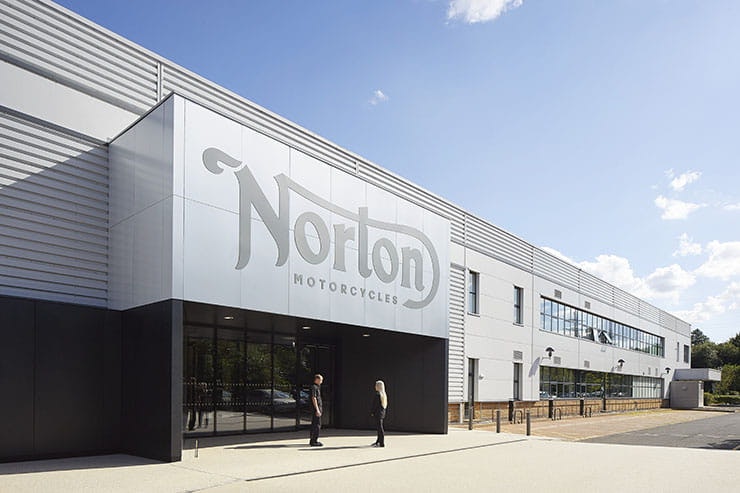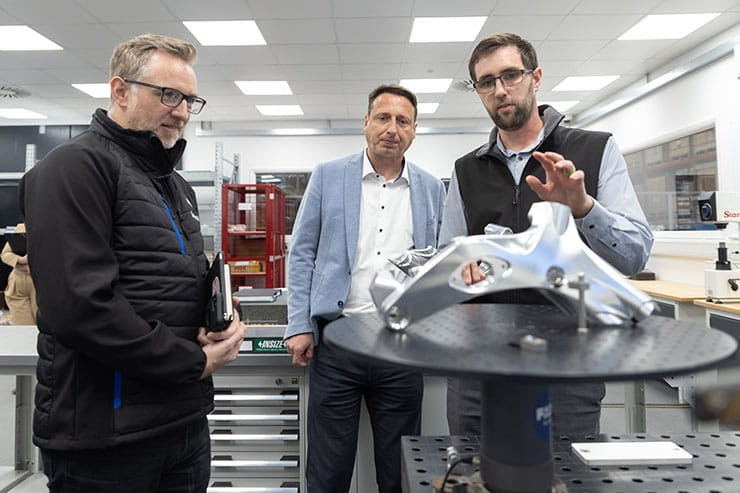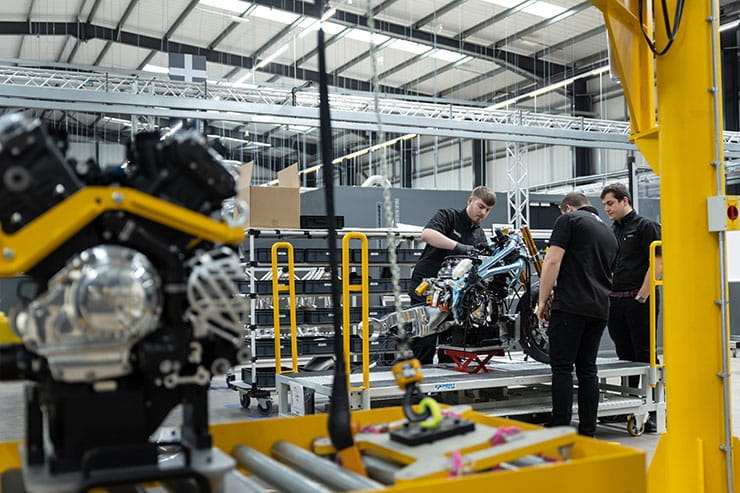New Norton: Behind the Scenes (inc. exclusive video)
By Michael Mann
BikeSocial Managing Editor. Content man - reviewer, road tester, video presenter, interviewer, commissioner, organiser. First ride was a 1979 Honda ST70 in the back garden aged 6. Not too shabby on track, loves a sportsbike, worries about helmet hair, occasionally plays golf and squash but enjoys being a father to a 7-year old the most.
11.11.2021
To say that Norton Motorcycles has enjoyed a stellar legacy from years of first-class leadership is like describing EastEnders as a serene neighbourhood where everyone gets along.
The British marque was established back in 1898 with its first motorcycle – the Energette – rolling out in 1902. It’s turbulent, soap opera-esque history has seen highs and lows in the shape of racing success though the 50s versus the administrators being called in during January 2020 when the previous owner’s mismanagement (to put it politely) caught up with him.
Indian firm TVS, the world’s 6th largest motorcycle producer stepped in to rescue the firm and offered a shining light at the end of a gloomy tunnel filled with disgruntled customers, shoddy workmanship, cut corners and a brand reputation firmly in the gutter. Long-standing TVS associate, John Russell, steadied the ship as Interim CEO with whom we spoke at the back end of last year, but a new, permanent leadership team has since been installed and we not only had the pleasure of a guided tour around the new 75,000 ft2 production facility in Solihull, West Midlands, but also spoke to the new CEO, Dr. Robert Hentschel, about the present and future of the Norton.
Behind the scenes at New Norton, inc. CEO interview
We go behind the scenes at the new 75,000ft2 Norton facility to discover just how much TVS has invested thus far, includes an interview with CEO Dr. Robert Hentschel (Transcript below)
Not only does the impressive new facility gleam on the outside, but the reception area is also grand, bright, airy, fastidiously clean and almost imposing with tall ceilings. You’re greeted by a brand-new V4SV – Norton’s latest, updated and upgraded version of the ill-fated V4SS – sitting on a plinth surrounded by a 20ft high net curtain, alongside five pristine models from the firm’s history emphasising the history and future. The initial perception from this re-born brand smacks of quality, accuracy, attention to detail with a significant amount of investment. In stark contrast to the more ‘cottage-industry’ feel of the previous generation of Norton ownership. Incidentally, since the V4SV was official announced just last week, the company have received 60 enquiries already.
Having been welcomed by Dr. Hentschel and shown an immaculate maintenance area that would give hospital operating theatres a run for their money for hygiene, the first port of call behind-the-scenes was the Inspection Lab. Here we meet Head of Quality, Chris Temple, an almost unenviable role such are the incredibly high standards of product quality set by the new owners. Chris introduces a laboratory full of hi-tech equipment for measuring, inspecting and validating third-party components that must meet strict benchmarks to be considered for new machines from this reinvented brand.
To offer some sense of the scale of the operation here, 600,000 individual parts that were part of the stock transfer from the previous generation of Norton have already been inspected, which is only 30% of the overall journey. New Norton started with 221 suppliers in the network with only 30 who’ll continue, once audited. The strict measures are evident throughout, referred to by Dr. Hentschel during our interview as creating a ‘sustainable Norton’.
One particular piece of apparatus is described by Chris as being “a very clever bit of kit designed for checking crankshafts and camshafts – it’s the only one of these in Europe and it’s kind of thing you’d only normally have you were manufacturing cams. The beauty is we can switch supplier or change cam profiles and we can validate all the parts in-house which is quicker and more efficient, but we can also control the quality of our stock. It’s extremely niche but it demonstrates the level that we’re going to. This is not a cheap bit of kit.”
And the appearance of large-scale investment from TVS is all too apparent every way you look. I expected Dr. Hentschel to whip out a pair of white cotton gloves and run his index finger along a shelf or worktop checking for dust.
Head of Operations, Matt Wharton, is responsible for the manufacturing and engine building process and production line. He’s just one of the 142 Norton employees, triple the amount brought over from the Donington Hall-based version of Norton. The management team are visible, they have to be to insert the feeling of team spirit.
Matt shows and example of another window where passers-by can see part of the Norton model creation, something in the future customers will be able to see. We watch a welder at work as he fixes a subframe of a V4SV to the main frame while Chris, who is responsible for 39 employees, divulges information about the investment in fabrication frames with fixtures designed for hand-welding but with flexibility to alter the processes in the future for robotic/automated welding if the desire is to amend it. “We can output a main frame in 5-6 hours with a couple of hours extra for an additional subframe and swingarm,” says Chris.
QR codes on each frame offer details on who welded it, using which machine and material, at which time on which date for complete traceability to demonstrating consistency across the manufacturing process.
Moving through to the Engine Build Room, and no expense seems to have been spared here either with a deliberately pressurised room where, at the moment, V4 engines are currently being pieced together. No external air can enter but the scrupulousness doesn’t end there as all 800 engine parts (per engine) go through a hot wash and vacuum drying process, to eliminate corrosion, before being pieced together like Lego by technicians already familiar with the engine build but have an electronic build manual… also just like Lego.
Once built, the engine is wheeled to one of seven build stations (though only four are currently operational) and have the other elements of the bike added from frame, suspension and wheels to brake system, coolants and looms. Four months in and everything created on the production line has been pre-production V4s and 961s.
And onto the rolling road, based on a proven dyno system that has been adapted for Norton, to the tune of £250,000. Yet again it has a window for customers to see how the bike is being tested but this time it has a screen replicating that which the technician can see inside the dyno. Each bike is tested in 6th gear at 75mph as a ‘power test’ to gather bhp data, as well as a front and rear brake test. If the bike passes then the end of line inspection under spotlights begins at the clutch lever and the technician works in clockwise direction.
The final element is CQPA (Customer Quality Perception Audit): pick a finished bike at random prior to shipping then static and dynamic test including a road test which takes just under one day for a thorough review.
Overall, Norton customers are going want to see a step change in terms of production processes, attention to detail, quality assurance and more improvements in design, manufacturing plus aftermarket share, and judging from what we’ve seen the new Norton seems at first inspection to have applied the appropriate business fundamentals. At the helm is a confident straight-talker with a background in the right areas and so with TVS’ investment thus far together with the West Midlands-based leadership team, the great British marque is seemingly in the right hands to repair what remains of the Garner-era and go on to new heights with perhaps not a blank canvas but one that has some exciting looking post-it notes attached already.
Interview with Dr. Robert Hentschel, Norton Motorcycles CEO: TRANSCRIPT
Personal past and future
I started in electrics and electronics and I’ve lead engineering service provider organisations and at some point I also was responsible for motorcycle engineering and urban mobility. Coming from that I now have an opportunity to lead Norton into a new era. For me it’s very important to build a sustainable Norton – I’m not talking about EV at this point in time, I’m talking about the financial sustainability of the company because the history, in some aspects, was bumpy. It was a rollercoaster tour and with the long-term investment of TVS, Norton now has the opportunity to be a sustainable company.
Bought a Norton in 2016
I visited Donington Hall in 2016 and the opportunity to look at the 961 production line and I made a spontaneous decision to buy one because I found it such a nice and exciting product. A few weeks later I managed to get it back into Germany, I still have it and at some point in time I will bring it here to this facility to be maintained.
I was always excited by iconic British brands, I also spent some time in my career at Lotus, and I got a call before Christmas last year and it didn’t take long to make the decision to join. I’m aware of what happened the last 12 months and the last years also – all of that for me is an opportunity to build on, and that is for me it is always the way to be challenging and interesting and that is for sure given.
Trebled team
Before I joined, I had not seen this facility, so I had to make the decision based on the history of old Norton and the interviews with TVS and the managements plus my experience and my gut feeling. By the day I came in the facility had already been established by 80% and I was super surprised by the level of quality in this facility, on the investment by TVS and it obviously reflected from the beginning the approach I wanted to implement – the lean, the modern, the modern luxury Norton brand with the most exciting products.
The investment you see here are visible. There are many things going on in the background to make a sustainable company. At the heart, I would say one of the most important elements of being successful is the quality of the product. If you demand a high price for something, you have to deliver high quality and that is what this facility is built around, including the supply chain. It’s not visible immediately but it’s so important for building the brand that we focus on a high-quality approach and the mindset of the people.
A start-up with heritage
When I face Norton customers, the majority are super excited in the brand itself and very interested in the way we want to go with Norton, and I have so much positive feedback from the complete motorcycle market on this opportunity. Obviously, we have customers who have old Norton products that we need to fix some problems, for example, the V4SS is a non-rideable product we have in the market, so we have to look after the customer and provide a good solution, that is the legacy we have to face and provide the best solutions for all of us. Then at the same point in time we are focussing and looking froward to creating exciting products. It’s a challenging time from different prospects but overall, I would say the brand is already perceived in a positive light.
Looking after brand advocates
For all new products that are coming, we will first of all look after deposit holders and also the owners of the V4SS who should not ride the bike. Clearly that is our focus and we have at the moment a situation where the old Norton is still under liquidation so we don’t know the outcome of that process, we have no influence on that process and I just want to make it clear, it’s not an excuse or something, but we do not have any liability to provide a resolution but it would be wrong not to do so because of the brand perception.
Operational fine-tuning
The TVS team and management team of the new Norton, made an incredible job because we all know Corona has restricted us from working on site. The planning and visibility of all the different stations was already in place but over the last four, five months the focus was very much on the professionalisation of the organisation. The processes in delivery of the engineering issues with the old bikes, establishing and polishing the supply chain, getting new suppliers and all the invisible elements as well as finalising the planning and execution of the facility.
Product Plan
We have defined a 10-year product plan which has been approved. The financial aspect of the product is under finalisation, so the product plan might change if that does not work. But we have an idea about which product will come at which point in time. I can say for the 961 we are investigating at the moment about bringing that bike back to the market. We need make sure all our products are safe, that’s clear, and have a quality standard which reflects the new Norton business.
We then have obviously an element of electrification, it would be wrong not to look at electrification with all the changes in legislation. That’s what I can tell at the moment about the product plan, it will be a mix of exciting products with ICE and EV.
Growing Markets
We are investigating obviously providing vehicles to the growing big capacity Asian market but all that has to be taken under consideration with the complete business plan. Because if you relaunch a brand there’s an element of strength of the brand at the core and you can think about derived models from that, all of that is part of our product and business plan investigations.
Quick decisions
Before I joined, I had a product in mind, something where I thought if I get that job, I’m will make exactly that motorcycle. I’m not able to make a sketch so I asked my designer to read my mind and make a sketch which he did within 6-8 hours, and he came back with exactly the product I had in my mind. That is something where you will also see new product segments, we will create lifestyle around and focus is also to win younger customers.
I would not go so far that we talk about commuters, but I would with EV – probably there are different categories with EV, not just superbikes but it will be a bunch of interesting products, a mixture of ICE and EV.
Electric Experience
EV is not boring! If you look at the automotive industry there is already a huge acceptance for electric vehicle, and to drive them is quite exciting because you have torque from 0rpm and this. That is something that is being established in the motorcycle industry I strongly recommend Norton is part of that.
Street Dealers
With the kind of approach we have taken with this facility, we have to create experiences for customers and I want the customer experience the same atmosphere you have in here in all our other places we will build globally. Obviously, we cannot build up experience centres by 500 or more globally but it will be something where we have to mix our approach to be close to customers; a mixture of customer experience but also to provide a digital backbone to establish this process. I’m a fan of having direct contact to the customer so as not to dilute the brand value by having different levels of dealership.
Next steps
For the Motorcycle Live show in Birmingham, we will show a derivative of the V4SV. I have yet to see the design models so far, so that’s this week I will see the printed model, so the plan is to have a derivative for the show.
To develop new vehicles takes 2 – 3½ years so as a consequence we have to look at opportunities to offer our existing products like 961 or V4. The SV is already decided and that is a process where we need to finalise validation first before we can make an announcement. 961 is also in the investigation phase where we look at the quality and supply chain in all the different elements of the motorcycle. So that is what you can expect in the next 1 – 2 years.
Racing; yes or no?
Racing is indeed an element of the DNA of Norton, no question. But I am also responsible for the profitability of the company, so we need to balance that. Easy answer: I would like to win the Isle of Man TT, no question about that but it has to be aligned with the processes of the company because the shareholders will expect a return on investment. So in the situation of balancing out but it is something that will help the brand to grow.
Share on social media:


